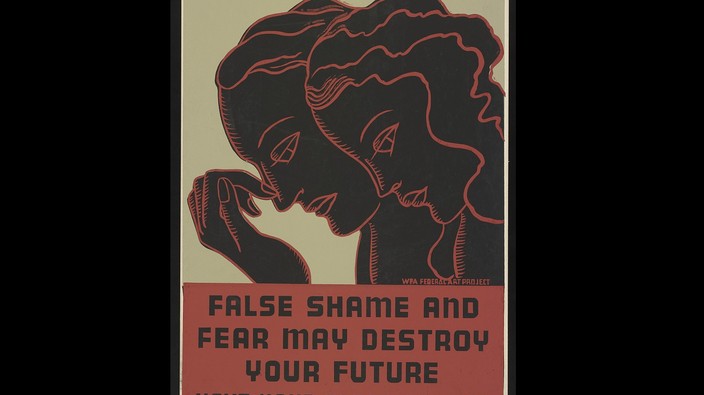why are syphilis cases surging?
the sexually transmitted infection is up to 'horrifying' levels in alberta.

a wpa federal art project poster on syphilis from 1938. rates in alberta have shot-up to numbers not seen since the 1940s.
wpa federal art project/library of congress
syphilis is back in a big way.
the sexually-transmitted infection is exploding in alberta right now. there are currently 2,509 cases in the province — a particularly high number when you consider that in 2000, there were only 17.
the current rates of syphilis are higher than they’ve been since the 1940s, before antibiotics were introduced, cbc news reported. dr. ameeta singh, an infectious disease specialist who works at edmonton’s royal alexandra hospital, told the outlet the numbers are “horrifying.”
but alberta’s definitely not the only part of the country dealing with a syphilis outbreak. nunavut and manitoba trail closely, according to statistics canada, with 734 and 559 per cent increases, respectively, in cases between 2014 and 2018. quebec and new brunswick have also dealt with high caseloads in recent years.
the pandemic has exacerbated the situation, singh told the edmonton journal: many of the nurses who would normally diagnose and treat stis are busy dealing with covid-19, and public health measures are limited.
while syphilis is, of course, an sti, it can also be transmitted in other ways. congenital syphilis — passed from a mother to a baby during pregnancy — is rising quickly in both alberta and manitoba, where there were 45 cased recorded in 2019.
advertisement
“the expected number of cases should be zero,” singh told the edmonton journal. “in canada today, we should not be seeing any cases of congenital syphilis because we know how to prevent and treat this infection.”
pregnant women can be tested for syphilis through blood or urine, and if a test comes back positive, it can be treated with penicillin. “if treatment is provided early in pregnancy, it can prevent the severe consequences to the infant,” singh said. (pregnancies in people with syphilis have an increased risk of ending in miscarriage or stillbirth. not all babies born with congenital syphilis will have symptoms, but they’re at a high risk of developmental delays, seizures, anemia, jaundice, and deformities, according to healthline.) “but the trouble is that many of the women who have delivered infants with congenital syphilis have not been presenting for prenatal care until later on in the pregnancy.”
the same is true of the infection more generally. if it’s identified early enough, it can be cured easily. but left untreated, it can become tertiary or late-stage syphilis, which can cause severe damage to the brain, nerves, eyes, heart, blood vessels, liver, bones and joints.
advertisement
here’s what you need to know about what syphilis looks like and how you can protect yourself.
signs and symptoms
a syphilis infection usually starts with painless sores on the mouth, genitals or rectum, according to the mayo clinic. that’s often followed by a rash that begins on the stomach, chest or back and spreads across the entire body. there may be more sores at this point, often in the mouth or the genitals. muscles aches, fever, and swollen lymph nodes sometimes occur in this stage.
a syphilis infection usually starts with painless sores on the mouth, genitals or rectum, according to the mayo clinic. that’s often followed by a rash that begins on the stomach, chest or back and spreads across the entire body. there may be more sores at this point, often in the mouth or the genitals. muscles aches, fever, and swollen lymph nodes sometimes occur in this stage.
these first two stages are when it’s most infectious — but they’re also when it’s most easily confused with other illnesses.
these symptoms might go away, but that doesn’t mean the syphilis is gone — in fact, it could mean it’s gone into the hidden or latent stage, which can last for years before, in some cases, developing to tertiary syphilis. it can also affect the eyes (called ocular syphilis) or the brain and nervous system (neurosyphilis).
you should get tested or see a doctor if you experience unusual rashes, discharge or sores — especially if they’re in the groin.
causes and risk factors
having sex without using a condom or dental dam is one of the biggest risk factors for syphilis. making sure to use protection is the easiest and most effective way for sexually-active people to protect themselves from stis.
having sex without using a condom or dental dam is one of the biggest risk factors for syphilis. making sure to use protection is the easiest and most effective way for sexually-active people to protect themselves from stis.
advertisement
getting tested regularly is also an important way to stay safe. research has shown that many people avoid tests because they underestimate their risk of contracting an sti. there’s still stigma around sti testing, but there shouldn’t be: one in two sexually active people will contract some kind of sti by age 25. and while many people — particularly younger men — worry that the test might be invasive or harmful, the reality is it’s usually as easy as getting swabbed, peeing into a cup, or extracting a small amount of blood.
there’s also a significant link between syphilis and the use of stimulant drugs, especially methamphetamine. “stimulant drugs not only stimulate the sex drive but also disinhibit behaviour and make it more likely that people will engage in risky sexual behaviour,” singh told the edmonton journal. dealing with the social determinant of health — by providing more resources to help with drug addiction, homelessness and mental illnesses, for instance — would help with the syphilis outbreaks, she added.
 4 minute read
4 minute read





